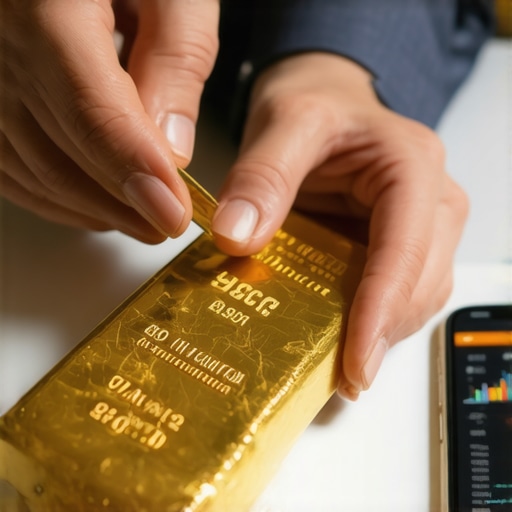Unearthing the Allure: Why Gold Bars Remain the Beginner’s Choice in Investment
Gold has long stood as a beacon of wealth preservation and financial security, especially during turbulent economic periods. For beginners venturing into precious metals, investing in gold bars offers a tangible, timeless asset that withstands inflation and market volatility. But the path to safely acquiring gold bars is often riddled with uncertainties — from authenticity concerns to choosing reputable sellers. This guide delves deep into expert insights and practical wisdom to help you confidently navigate your first gold investment.
Striking Gold Safely: Insider Tips for Authentic Purchases
Ensuring the authenticity of gold bars is paramount. Novices should prioritize buying from accredited dealers who offer certification from recognized assaying authorities such as the London Bullion Market Association (LBMA) or the American Numismatic Association (ANA). A certified gold bar not only guarantees purity — typically .9999 fine gold — but also eases liquidity when reselling. Another safety measure includes requesting assay cards and verifying serial numbers to prevent counterfeit risks.
What Are the Trusted Channels for Buying Gold Bars Without Risk?
Purchasing gold bars through established channels minimizes exposure to fraud and price gouging. Trusted avenues include:
- Reputable Dealers: Physical stores or online platforms with transparent pricing and positive reviews.
- Government Mints: Buying directly from national mints assures authenticity and standardized quality.
- Certified Auctions: Auctions hosted by recognized institutions can offer verified gold bars but require due diligence.
For beginners, platforms like this comprehensive guide on buying gold bullion safely provide detailed step-by-step instructions to avoid pitfalls.
The Weight of Wealth: Understanding Gold Bar Sizes and Their Impact on Your Investment
Gold bars come in various sizes, from as small as 1 gram to as large as 400 ounces. Beginners often find smaller bars more accessible due to lower upfront costs and easier storage. However, larger bars typically have a lower premium over the spot price, offering better value per gram. Balancing your budget, storage capabilities, and liquidity needs is crucial. For example, a 1-ounce gold bar offers easier resale potential in retail markets than a 400-ounce bar, which is often reserved for institutional investors.
Storage Strategies: Protecting Your Golden Assets Securely
Owning physical gold involves safeguarding it against theft, loss, or damage. Beginners should explore options like home safes with high security ratings, bank safety deposit boxes, or professional vault storage services. Each option has pros and cons: home safes offer immediate access but require robust security measures; bank vaults provide high security but limited accessibility; third-party vaults combine security with insurance but may incur ongoing fees. Deciding on storage depends on your comfort level, investment scale, and risk tolerance.
Expert Insight: How Does Investing in Physical Gold Compare to Gold ETFs or Stocks?
Physical gold bars offer direct ownership and intrinsic value, immune to counterparty risk. In contrast, gold ETFs and stocks provide liquidity and ease of trading but are subject to market fluctuations and company-specific risks. Understanding these differences helps tailor your portfolio to your investment goals and risk appetite. For an in-depth comparison, consult resources like Gold ETFs vs. Physical Gold: Which Investment Fits Your Portfolio.
Join the Conversation
Have you recently invested in gold bars or considered it? Share your experiences or questions in the comments below to help fellow beginners make informed decisions.
For further reading on building wealth with physical gold bars, explore expert tips for financial growth.
Source: The World Gold Council provides authoritative data and analysis on gold investment trends, confirming the enduring value of physical gold in diversified portfolios (gold.org).
Decoding Gold Bar Purity: Beyond the Surface
While most gold bars boast a purity of .9999 fine gold certified by reputable assaying authorities, nuances in refining processes can impact their actual market value and resale potential. Experts recommend examining the bar’s manufacturer reputation and assay certificate details meticulously. For instance, bars from well-known refineries like PAMP Suisse, Johnson Matthey, or the Royal Canadian Mint often command higher premiums due to trusted craftsmanship and global recognition.
Moreover, understanding hallmark stamps and serial numbering systems can help investors verify authenticity independently. This due diligence is particularly crucial when purchasing secondhand gold bars or through private sales, where the risk of counterfeit products increases significantly.
Storage Innovations: How Technology Enhances Gold Security
Traditional storage methods such as home safes and bank deposit boxes remain popular, but modern technology is transforming gold security. Smart safes equipped with biometric access, GPS tracking, and real-time monitoring are increasingly accessible to individual investors, offering enhanced protection against theft and unauthorized access.
Additionally, some professional vault services now provide insured digital custody solutions where physical gold ownership is tokenized, allowing investors to trade or transfer ownership seamlessly without moving the physical asset. This hybrid approach combines the tangible security of physical gold with the liquidity benefits typical of financial instruments.
How Can Investors Balance Liquidity and Security When Choosing Gold Bar Storage?
Striking the right balance between accessibility and security depends on investment goals and risk tolerance. If frequent trading or quick liquidation is anticipated, keeping gold in insured bank vaults or insured third-party storage with easy withdrawal options is advisable. Conversely, investors focused on long-term wealth preservation might prioritize high-security home safes with advanced locking mechanisms despite limited liquidity.
Exploring solutions like allocated storage accounts, where gold is specifically segregated and owned by the investor, can also optimize security without sacrificing liquidity. Such accounts are often offered by reputable dealers and vault providers, ensuring transparency and trust.
Market Dynamics: Central Bank Gold Purchases and Their Influence on Prices
Central banks worldwide play a pivotal role in shaping global gold price trajectories through their purchasing policies. Their acquisitions can signal confidence in gold as a reserve asset, influencing investor sentiment and demand.
Recent trends show heightened central bank activity, particularly among emerging economies diversifying reserves away from traditional fiat currencies. This trend has contributed to upward pressure on gold prices, as reported by the World Gold Council. Understanding these macroeconomic indicators can empower investors to anticipate market movements and adjust their strategies effectively.
Enhancing Your Gold Investment Knowledge
For those eager to deepen their expertise, resources such as Gold Supply and Demand Explained: What Drives Price Fluctuations provide comprehensive insights into the complex forces affecting gold valuations. Equipping yourself with this knowledge can refine your investment decisions and timing.
Engage with our community by sharing your questions or experiences with gold bar investments in the comments section below. Your insights contribute to a richer, informed dialogue among investors at all levels.
Navigating Authentication Complexities: Advanced Techniques for Gold Bar Verification
Beyond standard certifications, seasoned investors employ sophisticated methods to authenticate gold bars, mitigating risks posed by increasingly convincing counterfeit techniques. Non-destructive testing technologies such as X-ray fluorescence (XRF) analyzers allow for precise elemental analysis without damaging the bar, offering a rapid assessment of purity and alloy composition. Additionally, ultrasonic thickness measurements can detect internal inconsistencies or voids characteristic of counterfeit bars. Combining these technologies with visual inspections of micro-engraved security features—like laser-etched serial numbers and refinery-specific holograms—provides a multi-layered authentication approach that elevates confidence in the asset’s legitimacy.
Innovative Security Protocols: Integrating Blockchain for Traceability in Physical Gold Ownership
Emerging trends in precious metals custody involve blockchain technology to enhance provenance and transfer transparency. Tokenization of gold bars enables fractional ownership while maintaining a verified digital ledger of each bar’s lifecycle—from minting to current holder. This immutable record not only deters fraud but also streamlines transactions by reducing reliance on physical transfer and intermediaries. Platforms implementing this technology often partner with established refineries and vault operators, ensuring the physical gold underpins the digital tokens. Investors benefit from improved liquidity and traceability without compromising the intrinsic security of holding physical metal.
How Does Blockchain-Based Gold Ownership Address Traditional Limitations in Security and Liquidity?
Blockchain solutions create a decentralized verification framework that significantly reduces counterparty risk and enhances transparency. By cryptographically linking each token to a specific, segregated gold bar stored in insured vaults, investors retain ownership rights without the logistical burdens of physical custody. This system also facilitates near-instantaneous transfers and fractional trading, overcoming the liquidity constraints historically associated with physical gold. Furthermore, immutable transaction records provide auditability, helping regulatory compliance and dispute resolution. For comprehensive technical perspectives, the Investopedia Blockchain Overview offers foundational insights into these mechanisms.
Market Timing Insights: Interpreting Central Bank Policies and Macro Trends for Strategic Gold Acquisition
In-depth understanding of central bank behaviors and global economic indicators can significantly enhance timing strategies for gold investment. Central banks’ decisions to accumulate or divest gold reserves often reflect broader monetary policy shifts, geopolitical tensions, and currency valuation trends. For example, increasing gold purchases amid currency devaluation fears signal bullish momentum. Sophisticated investors monitor not only the volume of central bank acquisitions but also the geopolitical context, such as trade disputes or inflationary signals, to anticipate price movements.
Complementary to central bank activity, tracking supply-side constraints—like mining output fluctuations due to geopolitical instability or environmental regulations—and demand shifts in emerging markets can provide nuanced perspectives on price volatility. Integrating these macroeconomic variables with technical analysis and sentiment indicators offers a holistic approach to optimizing entry and exit points in gold bar investments.
Engage Deeper: Expand Your Expertise and Elevate Your Gold Investment Strategy
To truly master the complexities of gold bar investment, continuous education and active engagement with expert communities are invaluable. Delve into specialized literature, attend industry webinars, and participate in forums where market veterans dissect emerging trends and share practical experiences. We encourage you to explore our curated resource Advanced Gold Investment Strategies to deepen your knowledge. Share your insights or pose challenging questions in the comments below to foster a vibrant, expert-level dialogue. Your participation enriches the collective understanding and sharpens investment acumen for all.
Mastering Authentication: Cutting-Edge Techniques Beyond Certification
While traditional certifications remain foundational, expert investors now leverage advanced technologies to authenticate gold bars with greater precision. Techniques such as X-ray fluorescence (XRF) spectroscopy allow for non-destructive elemental analysis, confirming purity without compromising the bar’s integrity. Ultrasonic testing further detects internal anomalies indicative of counterfeits, while microscopic scrutiny of laser-etched serial numbers and refinery holograms adds an additional verification layer. These multifaceted approaches mitigate risks posed by sophisticated forgeries, ensuring portfolio integrity for discerning investors.
Revolutionizing Ownership: The Intersection of Blockchain and Physical Gold Security
Blockchain technology is reshaping the traditional paradigms of gold ownership by enabling tokenization—a process that digitally represents physical gold bars on immutable ledgers. This innovation not only enhances traceability and provenance but also empowers fractional ownership, facilitating liquidity previously unattainable with physical assets. By cryptographically linking tokens to specific bars stored in insured vaults, investors mitigate counterparty risk and streamline transfers without physical movement. Such integrations harmonize the tangible security of gold with the agility of modern financial instruments.
How Does Blockchain-Enabled Gold Ownership Mitigate Traditional Security and Liquidity Challenges?
Blockchain systems establish decentralized, tamper-proof records that verify each transaction and ownership transfer, drastically reducing fraud potential. This transparency builds investor confidence while enabling near-instantaneous trading and fractionalization, overcoming the liquidity limitations historically inherent to physical gold. Furthermore, the immutable audit trail supports regulatory compliance and dispute resolution. For a comprehensive technical exploration, Investopedia’s Blockchain Overview provides an authoritative resource.
Strategic Insights: Leveraging Central Bank Activity and Macro Trends for Timing Gold Investments
Seasoned investors monitor central bank gold reserve adjustments as a barometer for global economic sentiment. Increased acquisitions often foreshadow bullish price movements, particularly amid geopolitical tensions or inflationary pressures. Complementing this, scrutiny of supply-side disruptions—such as mining constraints due to regulatory or geopolitical factors—and demand surges in emerging markets enriches market timing strategies. Integrating these macroeconomic signals with technical analysis empowers investors to optimize entry and exit points, enhancing portfolio performance in volatile environments.
Elevate Your Expertise: Engage with Advanced Gold Investment Strategies
Continual learning and community engagement are indispensable for mastering gold investment complexities. Engage with specialized literature, webinars, and expert forums to stay abreast of evolving market dynamics. We invite you to explore our curated resource Advanced Gold Investment Strategies and contribute your insights or pose queries in the comments below. Your active participation fosters a vibrant expert community, sharpening collective acumen and empowering sophisticated investment decisions.
Frequently Asked Questions (FAQ)
What is the difference between gold bars and gold coins for beginners?
Gold bars generally offer lower premiums per gram compared to gold coins, making them more cost-effective for larger investments. Coins often carry numismatic value, which can fluctuate independently of gold price. For beginners focused on pure investment and wealth preservation, gold bars with recognized certifications provide straightforward purity and liquidity advantages.
How can I verify the authenticity of a gold bar beyond official certification?
Beyond certification, advanced methods include using X-ray fluorescence (XRF) analyzers to non-destructively assess elemental composition and ultrasonic testing to detect internal defects. Visual inspection of laser-etched serial numbers, refinery holograms, and hallmark stamps are also critical. Combining these techniques mitigates counterfeit risks, especially when purchasing secondhand or private sales.
What are the safest ways to store physical gold bars?
Safe storage options include high-security home safes with biometric locks, insured bank safety deposit boxes, or professional vault storage services offering segregation and insurance. Emerging technologies like smart safes with real-time monitoring and blockchain-enabled digital custody provide added security and liquidity. Choice depends on investor risk tolerance, access needs, and investment scale.
How do blockchain and tokenization improve gold bar ownership?
Blockchain technology creates immutable digital records linking ownership tokens to specific physical gold bars held in insured vaults. This enhances provenance transparency, reduces fraud, and enables fractional ownership and near-instantaneous transfers without physically moving the gold. It addresses traditional liquidity and security challenges by combining the tangible value of gold with modern financial instrument flexibility.
How do central bank gold purchases affect gold bar prices?
Central bank buying signals confidence in gold as a reserve asset, often driving demand and upward price momentum. Increased acquisitions, especially amid geopolitical or inflationary concerns, influence market sentiment and can foreshadow price trends. Monitoring these activities alongside supply and demand factors offers strategic insights for timing gold investments.
What size of gold bar is best for a beginner investor?
Smaller gold bars (1 gram to 1 ounce) provide lower entry costs and easier resale but usually carry higher premiums per gram. Larger bars (10 ounces and above) have lower premiums but require significant capital and may be less liquid in retail markets. Beginners should balance budget, storage, and liquidity needs when selecting bar sizes.
Is investing in physical gold bars better than gold ETFs or mining stocks?
Physical gold bars provide direct ownership and intrinsic value without counterparty risk, suitable for wealth preservation. Gold ETFs and mining stocks offer liquidity and ease of trading but introduce market and company-specific risks. The choice depends on investment goals, risk tolerance, and portfolio diversification strategies.
Can I trust private sales or auctions for buying gold bars?
Private sales and auctions can offer opportunities but carry heightened risks for counterfeit bars and pricing irregularities. Due diligence includes verifying provenance, requesting assay certificates, and employing advanced authentication tools. Beginners are advised to prioritize reputable dealers and certified sources to minimize risks.
What role does technology play in enhancing gold bar security?
Technologies such as biometric smart safes, GPS tracking, real-time monitoring, and blockchain-based custody solutions significantly enhance security and ease of ownership transfer. They provide layered protection against theft and fraud while improving liquidity and auditability for investors.
How does geopolitical instability influence gold investments?
Geopolitical tensions often increase demand for gold as a safe-haven asset, driving prices higher. Supply disruptions from mining regions affected by conflict or regulation can constrain availability, further impacting prices. Understanding these macroeconomic forces helps investors anticipate market volatility and adjust strategies accordingly.
Trusted External Sources
- World Gold Council (gold.org): Offers authoritative data, research, and market analysis on gold investment trends, central bank activities, and supply-demand dynamics, making it indispensable for informed decision-making.
- London Bullion Market Association (LBMA): Sets global standards for gold bar quality and certification, providing essential guidelines and lists of accredited refiners that ensure authenticity and market trust.
- American Numismatic Association (ANA): Provides expertise on gold bar and coin grading, authentication techniques, and collector resources, valuable for understanding certification and valuation nuances.
- Investopedia – Blockchain Overview: A comprehensive resource explaining blockchain technology fundamentals and its application in asset tokenization, critical for grasping innovations in gold ownership security.
- International Precious Metals Institute (IPMI): Offers industry insights, educational materials, and professional forums that deepen understanding of precious metals markets, authentication, and investment strategies.
Conclusion
Investing in gold bars remains a cornerstone strategy for wealth preservation, offering tangible value, intrinsic security, and resilience against economic uncertainties. Navigating this landscape requires a blend of foundational knowledge—such as understanding purity standards, trusted purchasing channels, and storage options—and advanced expertise in authentication technologies and market dynamics. Innovations like blockchain-enabled tokenization are revolutionizing gold ownership, enhancing liquidity and provenance transparency.
Monitoring macroeconomic factors, especially central bank activities and geopolitical developments, empowers investors to optimize timing and portfolio allocation. Whether starting with smaller bars or integrating sophisticated storage solutions, continuous education and engagement with expert communities are vital to mastering gold investment complexities.
We invite you to apply these insights to your investment journey, share your experiences, and explore further expert content to deepen your understanding. Your informed participation enriches the collective wisdom and helps fortify financial security through gold.










